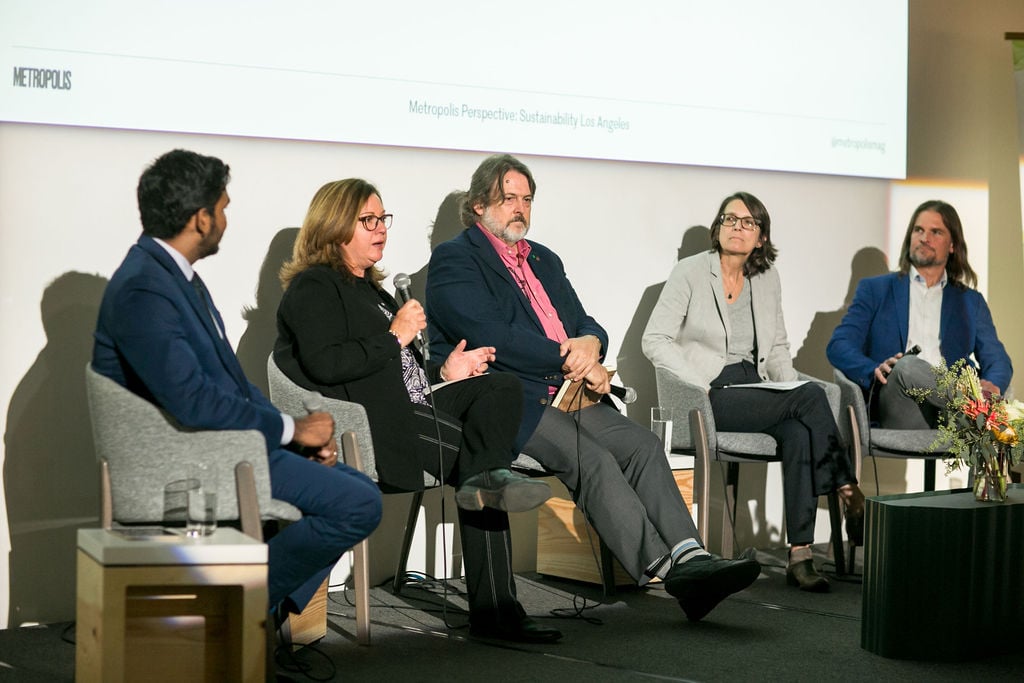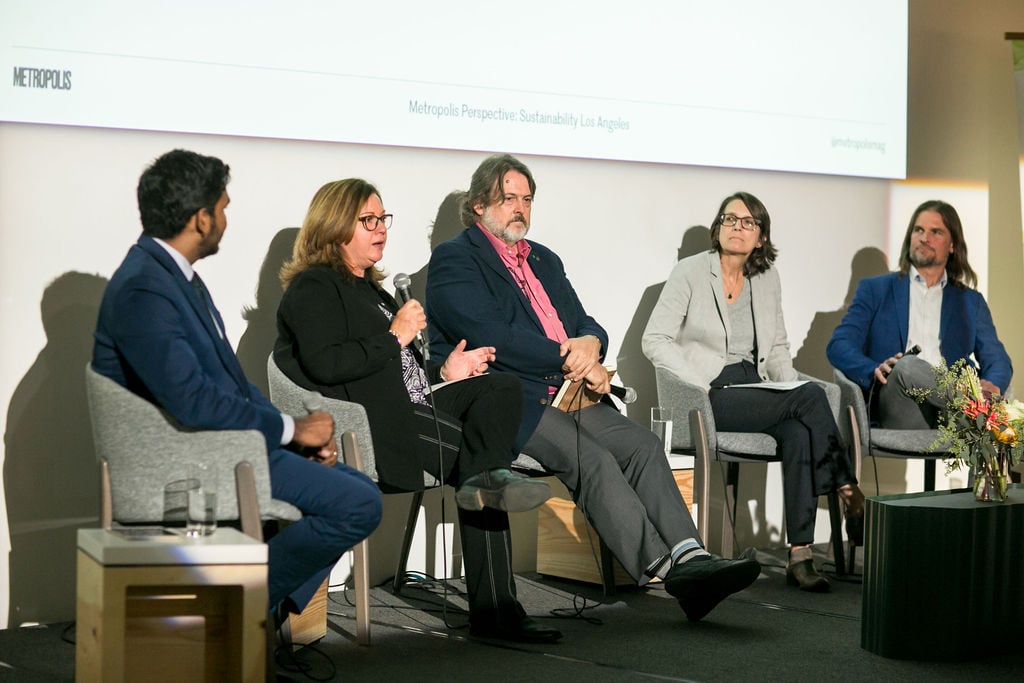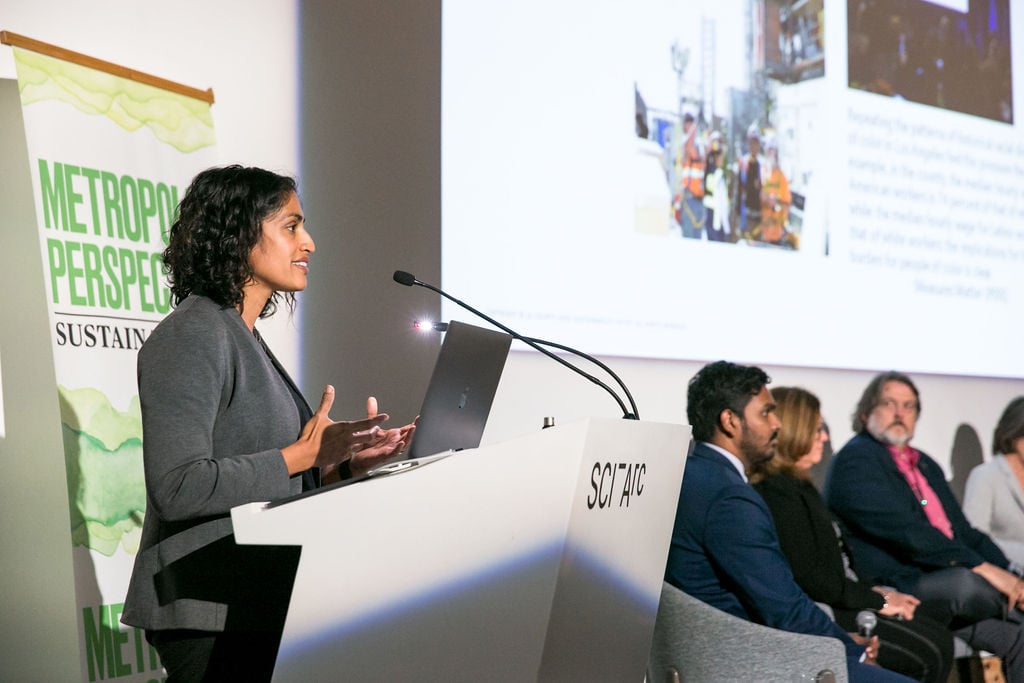
November 8, 2019
What is the Social Impact of Sustainable Architecture?
Panelists at the Metropolis Perspective: Sustainability event in Los Angeles last week bemoaned the challenges of measuring social equity within sustainability certification frameworks.

“Architects are best suited to solve the problems and challenges we face if we’re serious about an equitable future. But we need to design the policy frameworks in which we build—the only way we can make substantial changes is at the policy level.”
These comments from Angie Brooks, managing principal of Brooks + Scarpa, served as the frame for a recent discussion during Metropolis’ Perspective: Sustainability Symposium at SCI-Arc in Los Angeles, looking at how architects and designers can apply a social equity lens to sustainable design.
Echoing these sentiments in her opening keynote, Rita Kampalath of LA County’s Chief Sustainability Office emphasized that when it comes to planning for sustainability, policymakers and designers have the opportunity to “either exacerbate or improve inequality”.
Kampalath spoke to the process of developing the County of Los Angeles’ first comprehensive sustainability plan — adopted in August, the plan addresses sustainability issues across land use, transportation, public health and well-being, and housing across the 18 cities that make up LA County. According to Kampalath, rather including equity and inclusion as an addition to these 12 goals, they sought to make it an overarching thread across the whole plan, ensuring that as sustainability policy is enacted, housing and infrastructure improvements don’t unintentionally displace people. “If there are communities that can’t meet basic needs, LA can’t call itself a sustainable region.”

Brooks circled back to the idea that if architects actually want to create meaningful change for the systemic challenges cities face — where affordable housing and homelessness, transportation, sustainability and emissions are all intertwined — they need to get directly involved in the political process. She points to her own policy advocacy work with Livable Places, a non-profit development company she co-founded to create new affordable housing on under-utilized plots of land to counter the impact of sprawl in Southern California.
She also makes that case that many of the architects that have shown the greatest leadership as it relates to social equity have all spent time within city government — architect and civil rights leader Harvey Gantt who served as mayor of Charlotte North Carolina in the 1980s; Chicago’s new star chief planner Maurice Cox, formely mayor of Charlottesville, VA (who has commented that he was able to do more in one week as mayor than his whole career as an architect). And Deborah Weintraub, chief architect within the City of Los Angeles Bureau of Engineering who is leading the charge on inclusive projects like the LA River and the development of new homeless facilities.
For HKS Architects, bringing together equitable and sustainable design thinking has meant merging practice areas previously seen as distinct — no longer separating public interest and pro bono design work, or sustainability, equity and inclusion, and HR functions . The firm also brings a team of dedicated researchers to examine each project’s “nature of place”, looking at everything from the character of the local business community, local demographics around age and race, public health issues like asthma and obesity rates, and environmental factors like the impact on local watersheds. “Bringing together pieces that seem slightly unrelated has enabled us to uncover interesting aspects of the design process,” says HKS principal and chief sustainability officer Rand Ekman.
But how to benchmark those connections? Panelists agreed that while considerations for community can be found within the Living Building Challenge, LEED, and the UN Sustainable Development Goals, robust measurement and methodologies specific to social impact and equity as part of sustainable design are currently lacking.

Two product manufacturer representatives on the panel spoke of their companies’ journey with this issue. 3form’s Full Circle program, explained director of sustainability Mike Johnson, is a simultaneous effort to bring circularity to the manufacturing process—utilizing waste materials in new products—while applying those benefits to uplifting the artisan communities that the company works with around the world. Meanwhile, Tracy Backus, Teknion’s director of sustainability programs pointed out that material transparency and health could be a powerful focus for manufacturers and designers alike, since it has implications for sustainability as well as human well-being.
Brooks notes that for now the most impactful social equity metric is the most simple—whether her client, who she defines as the end user rather than who’s paying her—is happy. She cites a recent project with the Skid Row Housing Trust where an initial design concept was scrapped once she was able to get insight from a project design committee comprised of formerly homeless persons. The final result? A bright and modern 52 unit building called The Six that simultaneously addresses residents needs for safety and security while creating a unique new building layout—and achieving LEED Platinum certification.
The Los Angeles edition of Metropolis Perspective: Sustainability was held at SCI-Arc on October 30, and sponsored by 3Form, Armstrong Ceilings, Shaw Contract, Tarkett, Teknion, USG, and Aquafil.
You may also enjoy “Build Tall or Net-Zero? The Conundrums of Energy Efficiency”
Would you like to comment on this article? Send your thoughts to: [email protected]
Recent Viewpoints
Viewpoints
Navigating the Path to Net Zero





